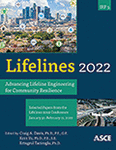Estimating Peak Floor Acceleration Using Artificial Neural Networks
Publication: Lifelines 2022
ABSTRACT
Peak floor acceleration (PFA) can be useful immediately after an earthquake to potentially optimize recovery resources, especially in cases of invisible damage that can be detrimental for essential lifelines. While code equations estimate PFA based on the design spectrum, simplified methods, available in the literature, have proven to be cumbersome for real-life structures. To mitigate this, a machine learning (ML) approach using Artificial Neural Networks (ANN) was investigated to quickly predict PFA using ground motion parameters and structural properties without the need for time-history analysis (THA) or providing ground motion time series. While previous studies fed ground motion time-series data to the ML model, this study investigates the use of ground motion parameters instead. Data from linear elastic THA were used to train the model. Results illustrated that a shallow ANN predicted PFA with coefficient of determination (R2) reaching 0.8; however, additional studies are underway to enhance the model performance.
Get full access to this article
View all available purchase options and get full access to this chapter.
REFERENCES
Abadi, M., Barham, P., Chen, J., Chen, Z., Davis, A., Dean, J., Devin, M., Ghemawat, S., Irving, G., Isard, M., Kudlur, M., Levenberg, J., Monga, R., Moore, S., Murray, D. G., Steiner, B., Tucker, P., Vasudevan, V., Warden, P., and Zheng, X. (2016). TensorFlow: A System for Large-Scale Machine Learning. 12th {USENIX} Symposium on Operating Systems Design and Implementation ({OSDI} 16), 265–283. https://www.usenix.org/conference/osdi16/technical-sessions/presentation/abadi.
Anajafi, H., and Medina, R. A. (2017). Evaluation of ASCE 7 equations for designing acceleration-sensitive nonstructural components using data from instrumented buildings.
Arias, A. (1970). A Measure of Earthquake Intensity. In Hansen (Ed.), Seismic Design for Nuclear Power Plants (pp. 438–469).
Bozorgnia, Y., Abrahamson, N. A., Al Atik, L., Ancheta, T. D., Atkinson, G. M., Baker, J. W., Baltay, A. S., Boore, D. M., Campbell, K. W., Chiou, B. S. J., Darragh, R. B., Day, S., Donahue, J., Graves, R. W., Gregor, N., Hanks, T. C., Idriss, I. M., Kamai, R., Kishida, T., and Youngs, R. (2014). NGA-West2 Research Project. Earthquake Spectra, 30(3), 973–987.
Chen, Z., Gandhi, U., Lee, J., and Wagoner, R. H. (2016). Variation and consistency of Young’s modulus in steel. Journal of Materials Processing Technology, 227, 227–243.
Conte, J. P., Durrani, A. J., and Shelton, R. O. (1994). Seismic response modeling of multi-story buildings using neural networks. Journal of Intelligent Material Systems and Structures, 5(3), 392–402. https://doi.org/10.1177/1045389X9400500312.
Dao, N. D. (2012). Seismic Response of a Full-scale 5-story Steel Frame Building Isolated by Triple Pendulum Bearings under 3D Excitations.
Elenas, A., and Meskouris, K. (2001). Correlation study between seismic acceleration parameters and damage indices of structures. Engineering Structures, 23(6), 698–704.
Gholizadeh, S., Salajegheh, J., and Salajegheh, E. (2009). An intelligent neural system for predicting structural response subject to earthquakes.
Guan M. EERI, X., Burton M. EERI, H., and Shokrabadi, M. (2021). A database of seismic designs, nonlinear models, and seismic responses for steel moment-resisting frame buildings. Earthquake Spectra, 37(2), 1199–1222. https://doi.org/10.1177/8755293020971209.
Guzman, J. M. E., and Ryan, K. L. (2015). Data from the network for earthquake engineering simulation/E-defense collaborative test program on innovative isolation systems and nonstructural components. Earthquake Spectra, 31(2), 1195–1209. https://doi.org/10.1193/083113EQS241.
Karimi Ghaleh Jough, F., and Şensoy, S. (2016). Prediction of seismic collapse risk of steel moment frame mid-rise structures by meta-heuristic algorithms. Earthquake Engineering and Engineering, 15(4). https://doi.org/10.1007/s11803-016-0362-9.
Kasai, K., Ooki, Y., Ito, H., Motoyui, S., Ozaki, H., Ishii, M., Kajiwara, K., and Hikino, T. (2010). Full-scale e-defense shake table tests on 5-story steel building with various dampers. Joint Conference Proceedings: 7th International Conference on Urban Earthquake Engineering (7CUEE) & 5th International Conference on Earthquake Engineering (5ICEE), 11–22.
Mitropoulou, C. C., and Papadrakakis, M. (2011). Developing fragility curves based on neural network IDA predictions. Engineering Structures, 33, 3409–3421.
Moschen, L., Adam, C., and Vamvatsikos, D. (2016). A response spectrum method for peak floor acceleration demands in earthquake excited structures. Probabilistic Engineering Mechanics, 46, 94–106. https://doi.org/10.1016/j.probengmech.2016.09.001.
Pinkawa, M., Hoffmeister, B., and Feldmann, M. (2014). A critical review of current approaches on the determination of seismic force demands on nonstructural components. Proceedings of the International Conference on Structural Dynamic, EURODYN, 2014-Janua, 421–428.
Pozzi, M., and Der Kiureghian, A. (2015). Response spectrum analysis for floor acceleration. Earthquake Engineering & Structural Dynamics, 44(12), 2111–2127.
Rathje, E. M., Dawson, C., Padgett, J. E., Pinelli, J.-P., Stanzione, D., Adair, A., Arduino, P., Brandenberg, S. J., Cockerill, T., Dey, C., Esteva, M., Haan, F. L., Hanlon, M., Kareem, A., Lowes, L., Mock, S., and Mosqueda, G. (2017). DesignSafe: New Cyberinfrastructure for Natural Hazards Engineering. Natural Hazards Review, 18(3), 06017001.
Sarma, S. K., and Yang, K. S. (1987). An evaluation of strong motion records and a new parameter A95. Earthquake Engineering & Structural Dynamics, 15(1), 119–132.
Suryanita, R., Maizir, H., and Jingga, H. (2017). Prediction of Structural Response Based on Ground Acceleration Using Artificial Neural Networks. International Journal of Technology and Engineering Studies, 3(2), 74–83. https://doi.org/10.20469/ijtes.3.40005-2.
Taghavi-Ardakan, S. (2006). Probabilistic seismic assessment of floor acceleration demands in multi-story buildings. http://blume.stanford.edu.
Xie, Y., Ebad Sichani, M., Padgett, J. E., and DesRoches, R. (2020). The promise of implementing machine learning in earthquake engineering: A state-of-the-art review. Earthquake Spectra.
Zhang, Y., and He, Z. (2019). Appropriate ground motion intensity measures for estimating the earthquake demand of floor acceleration-sensitive elements in super high-rise buildings. Structure and Infrastructure Engineering, 15, 467–483.
Information & Authors
Information
Published In
History
Published online: Nov 16, 2022
Authors
Metrics & Citations
Metrics
Citations
Download citation
If you have the appropriate software installed, you can download article citation data to the citation manager of your choice. Simply select your manager software from the list below and click Download.
